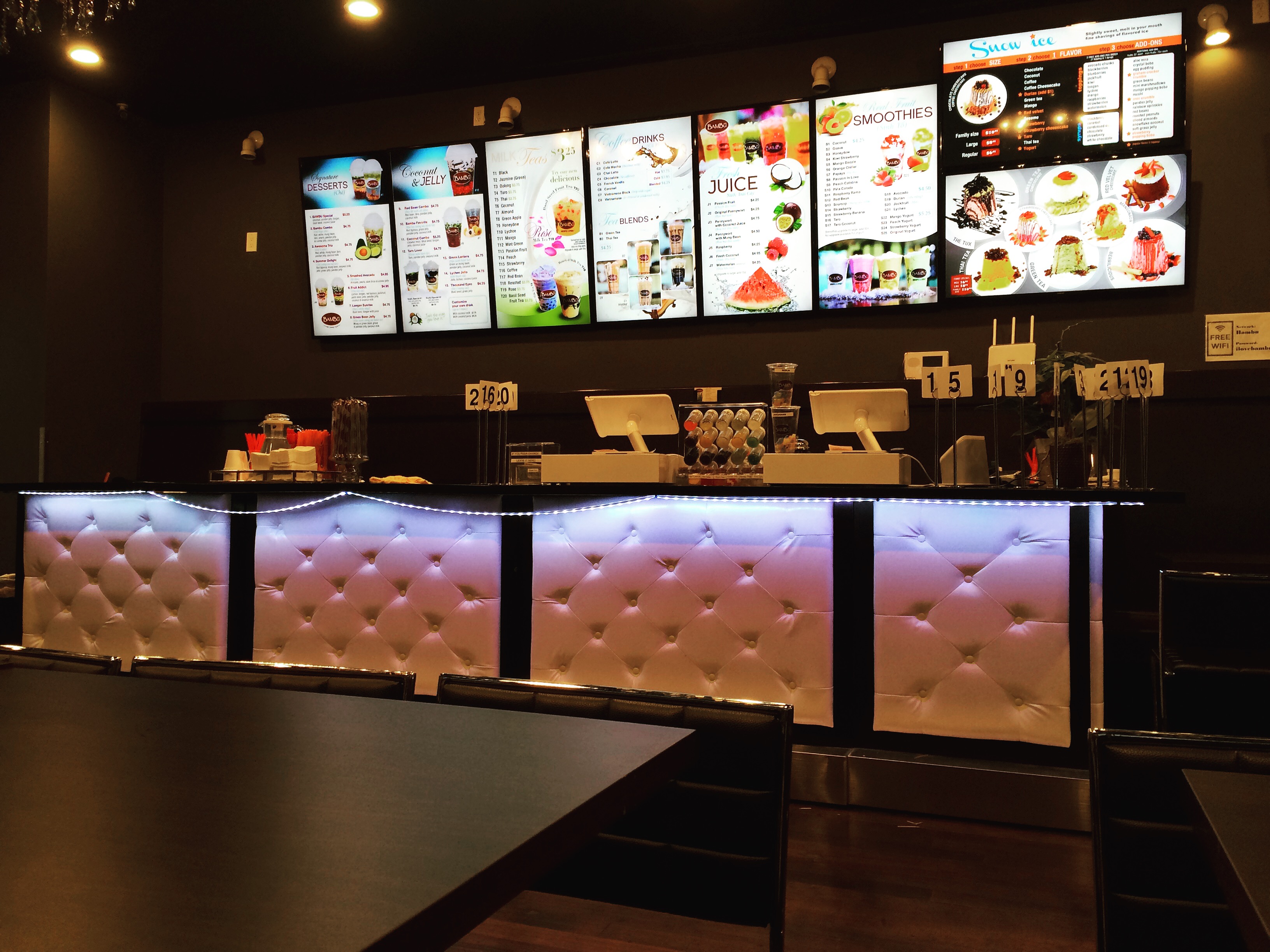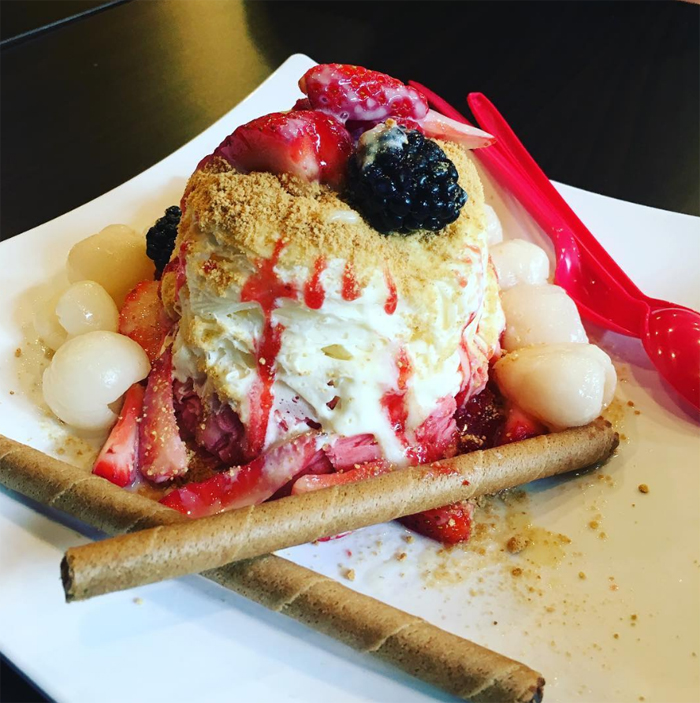By Stacy Nguyen
Northwest Asian Weekly

(Photo by Han Bui/NWAW)
Tucked in the middle of Chinatown is a new Vietnamese dessert establishment — the very first of its kind in Seattle. The interior of Bambu is sleek, clean, and airy. Board games are stacked on a shelf. Young customers — mainly Asian — chat at tables with friends as they sip from their dessert drinks. Behind the scenes, co-owner Dyane Ng, who is of Vietnamese descent, is manning the operations of Bambu. This Seattle location on 7th Avenue is the second Bambu in Washington (the other is in Kent). Ng and her business partners have their sights set on expanding the franchise into the University District and Bellevue over the next few years.
It’s hard to catch Ng in an idle moment. All of the juices and ingredients at Bambu are prepared fresh or from scratch — from the jellies to the fruits to the coconut juices.
Ng flashed her left hand — which was bare. “I lost my diamond ring chopping coconut,” she said, making the face-equivalent of a shrug. “I’m married, but I lost it.”
Beginnings
Bambu Desserts & Drinks was founded in 2008 by four Vietnamese sisters (unrelated to Ng) in San Jose, Calif, which is no surprise, as San Jose has the largest population of Vietnamese outside of Vietnam (100,486, according to the 2010 Census).
Specializing in Vietnamese chè (dessert soups or drinks), milk teas, fruit smoothies, and Vietnamese coffees and espressos, Bambu has since expanded to 50 locations in nine states.
No stranger to customer service, Ng was a hairstylist at a high end salon for more than 10 years, prior to opening Bambu locations in Washington state. Seattle is 11th in the nation, in number of Vietnamese (13,252, according to the 2010 Census), making it a good place for a Bambu location.
“I always loved doing stuff with people,” Ng said. “We all loved stuff with people,” she said, referring to her business partners (Minh Le, Amy Nguyen, and Binh Nguyen). “We’re people persons. And I’ve always wanted to create something. I always wanted to do drinks. I wanted to be busy.”
“Sometimes you feel like you hit a plateau,” Ng said, explaining why she left hair styling and switched to Bambu. “I wanted to do more.” The restaurant business is also in Ng’s blood. Ng’s folks had a Vietnamese rice plate restaurant on Jackson. Her aunt had a successful restaurant on Broadway.

Kasey Lay, a frequent Bambu customer, said that she discovered drinks can be customized for $5.25. Shown above is grass jelly, jello, and extra jackfruit in coconut juice. (Photo by Kasey Lau/NWAW)
Chè
“Chè is a sweet dessert,” said Amy Nguyen. However, it is not often eaten at the end of a meal; it is often eaten as a snack — and it has a lot of ingredients, depending on what type it is.
“There are a lot of beans. There are fruit. There are jelly types. And if you don’t want a certain ingredient, you can always add or remove what you do or don’t like,” said Nguyen, who is Ng’s sister and a business partner.
In Vietnamese, chè is an umbrella term for a variety of Vietnamese traditional dessert beverages, soups, or puddings, served hot or cold. The ‘body’ of chè runs the gamut, from tubers, beans, grains, and rice — to lighter seaweeds, tropical fruits, and coconut meat — to jellies made from agar agar, tapioca, and other starches.
It is ubiquitous in Vietnam, found in specialty cafes in cities, as well as from food vendors — mom and pop operations who hand out their homemade offerings in plastic baggies.
Even now, there is a dearth of ovens in Vietnamese homes. Meat tends to be grilled, sauteed, or fried on high heat — soups and braises simmered for long hours on low heat. Baked goods — breads and cakes — are typically purchased. Chè hails from this tradition of cooking on a stove or over a hearth.
And it’s this tradition that is the jumping off point for Ng and her business partners. “Our chè is traditional, but we give it a little spin,” said Ng. “In Vietnam, you just drink fresh coconut juice all the time. Here (at Bambu), we add fun stuff to [fresh coconut juice], like basil seed, pandan jelly.”
The hours she devotes to her business is exhausting, but ultimately worthwhile to Ng. She prides her Bambu locations on the freshness of the ingredients they use. She, her business partners, and her staff members wake up early each day to boil artichokes for tea, for instance. Vietnamese don’t eat artichoke as much as they drink it an infusion of it. Ng said it makes her heart sting a little bit, whenever she throws out a batch of artichokes after boiling them. She said that the taro in their snow ice has this fine graininess to it — because they don’t use powdered taro. They wake up, they boil, and they peel.

Strawberry cheesecake snow ice (Photo by Kasey Lau/NWAW)
Snow ice
There is a fair bit of autonomy between different Bambu locations and different owners. The Kent and Seattle locations, run by Ng and her business partners, are known for their snow ice. Snow ice is like shaved iced, but creamier and finer in consistency. When flavored with milk and fruit juices, it evokes the creaminess of ice cream.
“I’m not too familiar with Vietnamese desserts, but [Bambu’s chè] is pretty tasty. Although the number six — ‘fruit addict’ — had more jellies than fruit. … I’m definitely going to try snow ice next time!” said Soo Son, who is Korean, after she tried Bambu for the first time.
“It’s very creamy and tasty!” said Kay Lau, who frequents the Chinatown location of Bambu a lot. She said that it has become her gang’s conference room whenever they need to plan something.
Bambu Seattle is located at 512 7th Ave. S., Seattle. Bambu Kent is located at 18230 E Valley Hwy Suite 172, Kent. For more information, visit drinkbambu.com.
Stacy Nguyen can be reached at stacy@nwasianweekly.com.



